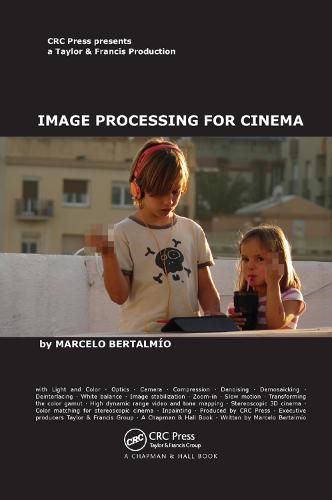Readings Newsletter
Become a Readings Member to make your shopping experience even easier.
Sign in or sign up for free!
You’re not far away from qualifying for FREE standard shipping within Australia
You’ve qualified for FREE standard shipping within Australia
The cart is loading…






Image Processing for Cinema presents a detailed overview of image processing techniques that are used in practice in digital cinema. The book shows how image processing has become ubiquitous in movie-making, from shooting to exhibition. It covers all the ways in which image processing algorithms are used to enhance, restore, adapt, and convert moving images. These techniques and algorithms make the images look as good as possible while exploiting the capabilities of cameras, projectors, and displays.
The author focuses on the ideas behind the methods, rather than proofs and derivations. The first part of the text presents fundamentals on optics and color. The second part explains how cameras work and details all the image processing algorithms that are applied in-camera. With an emphasis on state-of-the-art methods that are actually used in practice, the last part describes image processing algorithms that are applied offline to solve a variety of problems.
The book is designed for advanced undergraduate and graduate students in applied mathematics, image processing, computer science, and related fields. It is also suitable for academic researchers and professionals in the movie industry.
$9.00 standard shipping within Australia
FREE standard shipping within Australia for orders over $100.00
Express & International shipping calculated at checkout
Image Processing for Cinema presents a detailed overview of image processing techniques that are used in practice in digital cinema. The book shows how image processing has become ubiquitous in movie-making, from shooting to exhibition. It covers all the ways in which image processing algorithms are used to enhance, restore, adapt, and convert moving images. These techniques and algorithms make the images look as good as possible while exploiting the capabilities of cameras, projectors, and displays.
The author focuses on the ideas behind the methods, rather than proofs and derivations. The first part of the text presents fundamentals on optics and color. The second part explains how cameras work and details all the image processing algorithms that are applied in-camera. With an emphasis on state-of-the-art methods that are actually used in practice, the last part describes image processing algorithms that are applied offline to solve a variety of problems.
The book is designed for advanced undergraduate and graduate students in applied mathematics, image processing, computer science, and related fields. It is also suitable for academic researchers and professionals in the movie industry.